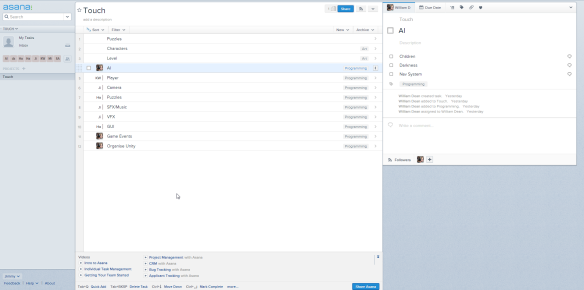Today we did another planning session. We used the whiteboard and plotted out what we would like in the game as an entire team.
Some of the ideas passed around were:
- Children being commanded to walk / stop
- Children getting distracted and walking off or getting scared and running to MOM
- Cutscenes for the game
- Having the darkness cloud move on a path instead of a wall of smoke
- changing the enemies to a cloudy hand or hands
- Discussion about the hand holding
- Children pointing out useful parts of a puzzle
- Using the darkness in sequenced events to come into a room
- Having a sequence of keys to save a child from being grabbed by the darkness
I think a lot of these suggested ideas were a bit ambitious for instance, commanding the children to do things. This example in particular, because we haven’t done anything like this before, we don’t know if it will work. For instance, if the mother commands a child, how will she do it? Will she point a cursor? Will this require some sort of HUD? or a crosshair? Will that take away from the game and make it seem like an action game? The main reason I wouldn’t want to do this is because you’d have to have advanced pathfinding, and where’s the limit to how far the children are allowed to walk?
The button sequence of freeing a child from the grips of the darkness seemed to me like it was also taking away from the main feel of the game. I mean, it will feel more like an action game to me if you had to press the correct combination of keys. I also made note to the team that this might not even be something a player will see in the game if they can do puzzles with ease, so do we really need to spend time on it? I felt that having the children just be pulled into the darkness would be a good idea.
We also discussed the scope of the game and agreed that we would be releasing a polished “demo” of the game. This will be the form of something we can show people to get funding or for getting the game out there. If we have a nice polished demo, people will want to play the full game, and then we can make it. So the aim for us is to get 2 or so “levels” with various puzzles in them that will lead to some sort of cliffhanger (like Limbo) where the player will be left with wanting more.
Another idea I suggested was that if a child is taken by the darkness / falls of a cliff / whatever, it displays on the screen “Press B to reload last checkpoint”. This will stay on the screen until you press it while the game is still playable. However, if you don’t press B in a few seconds and start walking this message will disappear and you can play the game without the child or children. This goes back to the original idea of the game where Dexter wanted the player to make a “moral choice” whether to continue with or without the children. The up side of having no children is that you are presented with easier puzzles, and you move quicker, but you don’t have the warm company of the children by your side. We really want the player to connect with the children and we will do that by giving them a personality and having them helpful in the game. However, doing this would require us to create puzzles that can be done with or without the children. I suggested that later on in the game, the player learns that they can send either blue or orange energy to buttons and activators with their mind (using a button and a left or right trigger) this way most puzzles that would normally need the children to activate can be done by just the mother. We didn’t discuss this fully yet, but I think it would be an easy way to implement the game so that people could dump the children without having to create puzzles that can be done multiple ways.
Another thing I’ve been noticing about this game is that the idea of most stuff in it are stolen from either Ico or Journey.
[youtube=http://www.youtube.com/watch?v=i1AK4fJp5uU&w=560&h=315]
For instance, looking at Ico, it’s in an old ancient city, it has a mostly white character *the mother / the princess in Ico), it has dark shadowy creatures in it (like in Ico) that attack the useless players (the children in Touch, and the princess in Ico). You have to solve puzzles (Ico) and you have to take someone to a distant land (I think.). I just hope we are not accused of blatantly ripping off a game idea.
So anyway, today we started using Asana, which is a task management app. At the end of the day we had quite a few tasks up which is great. The next step is to refine these and group them, and then we can start figuring out how long each one will be. Finally, we will then create a gantt chart of the timeline, complete with milestones for finishing certain elements.



